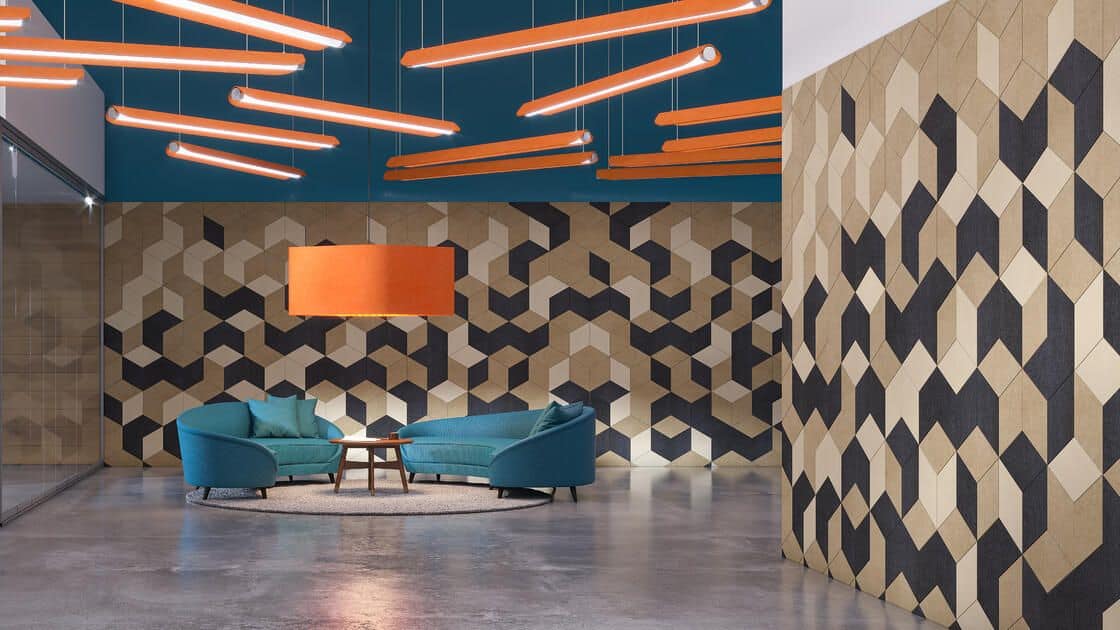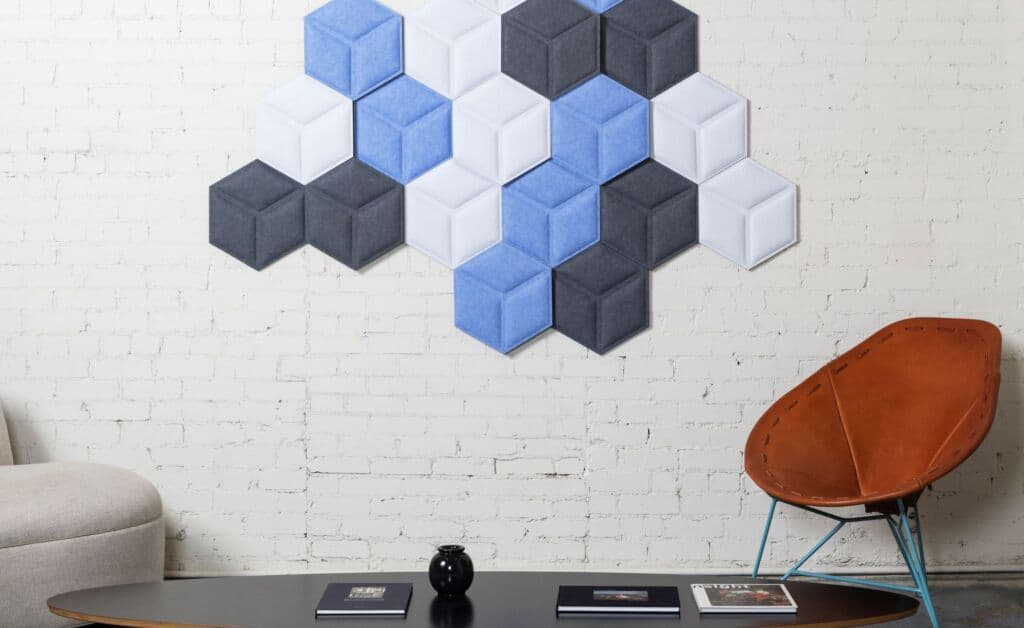Have you ever noticed how a well-designed room feels more comfortable and easier to stay focused in? That’s often thanks to good acoustics. Understanding the complexities of sound absorption is crucial for designing spaces with optimal acoustics. More specifically, the sound absorption coefficient, also known as the noise reduction coefficient (NRC), determines how well a substance diminishes sound waves. This is essential for creating comfortable acoustics in environments of all sizes and uses. When sound is absorbed effectively by the room’s finishes and furnishings, it can translate to a better meeting experience—people feel calmer, their attention span lasts longer, and overall communication improves.
Keep reading to learn more about sound absorption, the coefficients of popular materials and how to determine the amount of material required for a specific space.
Understanding the Sound Absorption Coefficient
The sound absorption coefficient indicates a material’s capacity to absorb sound energy on a scale of 0 to 1 — with 1 denoting complete sound absorption (no reflection), and 0 representing perfect sound reflection. Materials with higher absorption coefficients are better at minimizing sound wave reflection, therefore reducing reverberation and improving the overall acoustic conditions in a room.
Sound Absorption Coefficients: Why Are They Important?
Sound absorption coefficients are significant because they show how sound behaves in different settings. By selecting materials and surfaces based on their specific sound-absorbing qualities, it’s possible to manage and reduce unwanted sound.
For instance, to control the sound and avoid excessive noise, the walls and ceilings of a concert hall are often coated with materials with high sound absorption coefficients.
Commonly Used Materials & Their Sound Absorption Coefficient Range
Since different materials have different degrees of sound absorption, making the right selection for your acoustic requirements is important.
- Fiberglass panels: Fiberglass panels are a popular choice for studios and auditoriums because of their high effectiveness.
- Acoustic foam: Adaptable and extensively utilized, acoustic foam provides effective absorption over various frequencies.
- Rockwool panels: Rockwool is dense and good at absorbing sounds from mid- to high-frequency ranges.
- Fabric-covered panels: These panels combine absorbency with style and practicality.
- Wooden panels: These panels contribute to noise control but are less absorbent and offer a decorative element.
- Concrete walls: Due to their high reflectivity, bare concrete walls need extra absorption to control noise effectively.
Calculating Sound Absorption Material Needs
Choosing the right sound absorption material for a specific space involves several important considerations — the room’s size, shape and desired acoustic control. An analysis performed by a trusted AV professional will give you the information you need to create an optimal sound environment.
Dimensions of the Room:
Unevenly shaped rooms may have spots where sound waves reflect more, requiring careful positioning of absorption panels. More sound-absorbing material is necessary in larger spaces to effectively control noise.
Purpose of the Space:
The necessary degree of sound absorption depends on the space’s intended function. For example, acoustic control is more critical in recording studios and auditoriums than in casual living areas.
Selection of Materials:
Choose sound absorption with suitable absorption coefficients for your intended space and purpose. For instance, medium-absorption materials such as acoustic foam might be enough for a home office, whereas high-absorption materials like fiberglass might be advantageous in a recording studio.
Coverage Area:
To determine the amount of coverage necessary for efficient sound absorption, compute the space’s total surface area, including the walls, ceilings and floors. It is crucial to consider sound-reflective locations.
Frequency Considerations:
Some materials are better at absorbing particular frequencies than others. Be sure to select materials that work well for the specific frequency range in your space.
Panel Positioning:
Optimal placement of sound-absorbing panels is critical. An acoustic management professional can help you determine the best positioning for your sound absorption products.
Applications of Sound Absorption Coefficients
Some common insulation materials also have useful sound absorption coefficients. Knowing the sound absorption coefficient of different materials may help you determine multi-use products. Different levels of insulation include:
- Soundproofing: When you need a room to be completely, acoustically isolated from its surroundings.
- Noise barriers: Typically, a noise barrier is an outdoor structure intended to lessen noise pollution — think about walls built to block highway noise from adjacent residential neighborhoods. For an effective noise barrier, the sound absorption coefficient of the construction material must be as close to one as possible.
The Bottom Line
Whether you’re envisioning a concert hall, conference room, home theater, welcoming lobby or recording studio, your visitors’ experience improves by creating an acoustically balanced setting. Acoustic management blends science and design, enabling us to control our auditory experiences and create environments that resonate with clarity and comfort.
Making informed choices for acoustic treatment is possible when you understand the underlying concept and know the properties of frequently used materials.
Want to customize the best materials to your space and create an overall acoustic management plan? Talk to the experts at DGI about your space and how sound absorption can make a difference.



